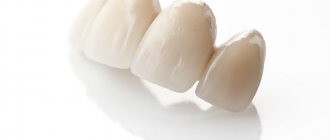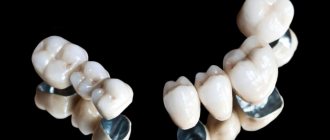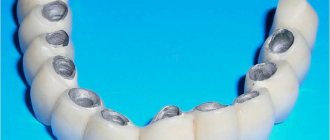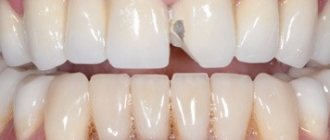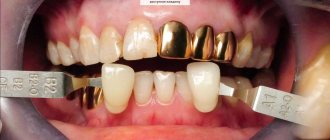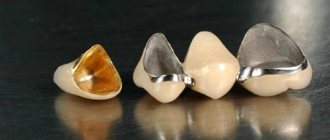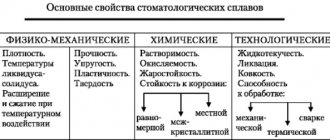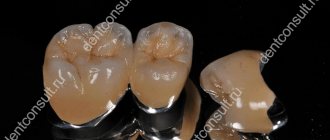What is a metal-ceramic crown?
Today, the choice of materials for making dental crowns is very wide: ceramics, zirconium dioxide, and plastic, but metal-ceramics continues to be the most popular and affordable. At the moment, metal ceramics are a kind of gold standard in dentistry, since similar designs have been used by doctors for many years and have proven themselves to be good.
Metal-ceramic crowns are a “cap” with machined fissures, which is placed on a ground tooth and completely imitates its shape, including all anatomical formations. The basis for the structure is a metal frame, which is covered on top with a layer of ceramics, indistinguishable in color from natural enamel. The prosthesis is secured to the ground dental tissues using special composite or glass ionomer cement. In case of severe destruction, a metal tab is first installed, which serves as a reliable basis for the crown. Metal-ceramics are also used for the manufacture of bridges and clasp dentures supported both on the patient’s own teeth and on dental implants. In the latter case, the use of implants with metal abutments is recommended.
Methods for making a crown
Orthodontic products can be manufactured using several methods. Each of them has its own advantages and disadvantages.
Cast products
Strong and durable crowns are made using casting. For this, a single piece of metal is used. The method is not suitable for all materials.
Stamped
More affordable, but less durable prostheses are made by stamping:
- a mold is placed into the dental anvil;
- using rubber rings a stamp is obtained;
- the crown is made using special hammers that differ in shape and size;
- The product is given its final shape using small tongs.
Such crowns last less than cast ones, but are much cheaper to produce.
Pros and cons of a metal-ceramic crown
Among the advantages of metal-ceramic crowns is, first of all, their strength. Therefore, in most cases they are installed on chewing teeth. Undoubtedly, they look much better than purely metal crowns. In general, metal-ceramic crowns imitate real teeth well, but with the advent of new materials in prosthetics, preference in restoring anterior teeth began to be given to all-ceramic structures. When a combination of reliability and aesthetics is needed in the chewing area, then the best choice would be ceramic prostheses based on zirconium dioxide.
What are the alternatives?
As already noted, cermets can be replaced with products made from zirconium dioxide. Moreover, it can be used as “pure”, i.e. without facing, or facing with ceramic mass, and then firing. This is necessary if very white zirconium dioxide with minimal transparency is used - then the zirconium cap, after applying several layers of ceramics, will be indistinguishable from natural teeth and will last more than 20 years.
If the patient needs an extended bridge, then zirconium dioxide will make the restoration very expensive. In this situation, you can pay attention to cheaper, but lightweight and high-quality materials, for example, ceramic composite.
What are the differences between metal-ceramic crowns?
Indeed, many patients wonder: what is better - zirconium crowns or metal-ceramics? Roughly speaking, both structures are metal-ceramic, but zirconium is a “white” material that does not shine through the ceramic, as sometimes happens with ordinary metal. Therefore, today ceramic crowns on a zirconium frame are close in aesthetic qualities to all-ceramic crowns, but at the same time they have the same strength as metal-ceramics. However, prices for such prostheses are higher than for metal-ceramic structures without the use of zirconium.
The question of which is better - metal-ceramic or ceramic crowns cannot be answered unequivocally. The choice is made depending on the indications and budget. So, if prosthetics of the frontal group of teeth is necessary, it is recommended to choose solid ceramics. It is aesthetic metal ceramics. Typically, such crowns are placed on teeth where the chewing load is less, since the metal-ceramic frame is stronger. Regarding the issue of price, a metal-ceramic crown is, of course, cheaper.
Stages of metal-ceramic prosthetics
The process of dental prosthetics with metal-ceramics can be divided into two large stages: preparation and prosthetics itself. An initial consultation with an orthopedic dentist allows you to determine the scope of work to be done, assess the condition of the oral cavity, and discuss options for restoring the shape and function of the tooth. According to the drawn up treatment plan, the patient is sent for diagnostics.
Preparing teeth for metal-ceramic prosthetics consists of the following:
- Performing X-ray diagnostics. It allows you to determine the absence of inflammatory changes in the periodontal tissues and evaluate the quality of filling if endodontic treatment was previously carried out (the pulp was removed and the root canals were sealed). If the canals are sealed poorly - not completely or, conversely, with the filling material extending beyond the apex of the root, the doctor will unseal them and carry out repeated treatment.
- Professional teeth cleaning and caries treatment, replacing old fillings, if necessary.
- Depulpation - removal of a nerve. If the damaged tooth has not been depulped previously, the doctor performs this procedure in the following cases:
- the presence of inflammation at the apex of the tooth, pulpitis;
- the need for prosthetic replacement of a single-rooted tooth - the pulp must be removed.
If prosthetics of a multi-rooted chewing tooth is required, the pulp can be left intact - but the final decision on this is made by the dentist, taking into account the individual characteristics of the condition of the oral cavity and the structure of the dental system.
In order to determine how dental prosthetics are done with metal-ceramics, it is necessary to take into account the degree of tooth destruction. Thus, a stump inlay for a metal-ceramic crown is made in cases where the tooth’s own crown is destroyed by more than half - at the root, or if only thin walls remain.
And if a larger volume of tissue is preserved, a pin can be used - it is screwed into the root canal, and an artificial crown is installed on it.
The actual stages of dental prosthetics with metal-ceramics are as follows:
- Tooth preparation - grinding. The question of whether teeth are anesthetized during metal-ceramic prosthetics, as a rule, is not raised - of course, the specialist performs preliminary anesthesia to eliminate the patient’s discomfort during the procedure.
The doctor grinds the teeth and then takes impressions - this is necessary for the further production of artificial structures according to individual parameters. Turning is carried out in one of two ways:
- with a ledge - the orthopedic dentist forms a circular ledge along the lower edge, which protects the gums from contact with the metal frame and reduces the likelihood of possible complications - swelling, irritation from contact of tissues with metal. This method also allows the use of metal ceramics with shoulder mass - it is applied in the area of the ledge to increase the aesthetics of the structure, and makes it possible to hide a strip of metal that can be visible through the ceramics at the base of the structure. Turning with a shoulder also makes it possible to extend the life of the structure;
- without a ledge - this method is outdated, so it is rarely used today. It has significant disadvantages - it does not provide enough space for a crown and can disrupt the contours of the gums. A space is formed between the structure and the gum tissue, in which dental plaque accumulates, and the edge of the denture looks quite unaesthetic. The design may cause irritation to soft tissues.
When contacting the clinic, find out how dental prosthetics are done with metal-ceramics - using the first or second method. This will avoid possible troubles with further wearing of the structure.
- Making an impression. Using impression material, the doctor takes impressions of the ground teeth. In order to accurately reproduce the parameters of the teeth, the gums are shifted using rings or retraction threads.
- Installation of a temporary crown. Due to the fact that the production of a permanent structure takes a certain time - about 1-2 weeks, the doctor installs a temporary crown made of plastic. This is necessary to protect the tooth core from food and saliva, as well as to ensure aesthetics. While the patient wears a temporary crown, a metal frame is made in the dental laboratory, onto which ceramic mass is subsequently applied layer by layer.
- After the permanent crown is made, it is installed using temporary cement after preliminary fitting of the structure. If it does not cause discomfort, the doctor will fix the crown using other, permanent materials.
Types of metal-ceramic crowns
Metal-ceramic crowns have several classifications: according to the frame material and according to the ceramic material. Thus, according to the frame material, crowns are distinguished based on a chromium-nickel alloy, based on a cobalt-chromium alloy, and based on a gold-platinum (palladium) alloy (based on the so-called “noble alloys”). There is also another material that is used quite rarely - titanium alloy. Each of these types of metal-ceramic crowns has its own pros and cons. Traditionally, the most popular material is cobalt-chromium alloy. Based on the ceramic material, a distinction is made between conventional (high-temperature) and low-temperature ceramics. Low-temperature ceramics based on “noble” alloys look more aesthetically pleasing.
Indications and contraindications for metal-ceramic crowns
The indications for installing a metal-ceramic crown are the same as for crowns made of other materials. The main one is the index of destruction of the coronal surface of the tooth, equal to 0.6. Also, indications for installing a metal-ceramic crown are:
- any non-carious lesions, for example, fluorosis or enamel hypoplasia;
- abnormal development and position of the front teeth in adults, which for any reason cannot be eliminated by orthodontic methods;
- pathological abrasion or wedge-shaped defect;
- aesthetic defect in the crowns of natural teeth (changes in color and shape, loss of shine, etc.);
- inconsistency of existing artificial crowns with aesthetic and functional requirements;
- metal-ceramic crowns can also be used as a splinting structure for mild to moderate periodontitis;
Each of the above indications should be considered in the context of a specific clinical case. Contraindications include, for example, bruxism, as well as periodontitis, accompanied by severe tooth mobility. In addition, fixed prosthetics on implants also involves the use of metal-ceramic crowns.
Is it possible to put metal-ceramic crowns on the front teeth?
It is possible if the patient’s budget does not allow for all-ceramic crowns. There are no medical contraindications to the manufacture of metal-ceramic crowns on the frontal teeth. However, aesthetics in this case recedes into the background. Such crowns will not look very natural. Therefore, it is still better not to place metal-ceramic crowns on the front teeth.
What are they: materials
Crowns are made from different materials: some are more durable, others are only suitable as a temporary measure. Their cost, complexity of manufacturing and installation also depend on this.
Metal ceramics
The product has a metal frame and is covered with ceramics on top.
| Pros: | Minuses: |
| High strength. | Contraindicated for people under 18 years of age. |
| Aesthetics. | Not suitable for gum recession. |
Metal-ceramic crowns are suitable for installation only in adult patients.
Metal composite
The crown frame is made of an alloy of chromium and cobalt. From above it is covered with a photopolymer composite: while it is soft, it is given a shape, after which it is fixed with UV rays.
| Pros: | Minuses: |
| High strength. | Coloring from products with pigment. |
| Thin and invisible edges. |
People with metal-composite crowns need to follow a diet to prevent artificial teeth from changing color. It is not recommended to consume drinks with dyes and foods with a high pigment content.
Golden
The oldest material for making crowns is gold.
| Pros: | Minuses: |
| Hypoallergenic. | Lack of aesthetics. |
| They do not damage neighboring healthy teeth. | Rapid abrasion due to the softness of the metal. |
It is best to install gold crowns on the back teeth, where they will be almost invisible.
Zirconium dioxide
Modern material for crowns is zirconium dioxide. It is durable, aesthetic, does not cause allergies and lasts a long time. But it has a fairly high cost, so it’s not suitable for everyone’s budget.
Metal-free
Modern synthetic materials can completely replace metal in the composition of the crown. They are no less durable, and look as close as possible to natural teeth.
Ceramic
The best way to choose the color of a crown is when it is made of ceramic. They do not look artificial, as they are quite transparent.
They are great for replacing incisors. But for chewing teeth, ceramic crowns are too fragile and cannot withstand such a load.
Porcelain
Porcelain crowns are not so popular, but are gradually becoming more and more in demand. They are easily and firmly fixed, which reduces the risk of loosening. Porcelain products last a long time, do not deteriorate due to temperature changes and are not stained by food. In this case, the crown can be made in an anatomical shape, repeating the relief of the tooth as accurately as possible, which ensures comfortable wearing. They look very aesthetically pleasing and are also hypoallergenic.
One of the disadvantages is their loose fit to the tooth, which can cause cervical caries. Crowns are quite fragile and can destroy adjacent healthy teeth. The product is not suitable for patients with thin enamel. In addition, the cost of such crowns is quite high, which is not affordable for everyone.
Combined
By combining several materials, it is possible to create crowns that combine their best properties. The product is suitable for use on front and back teeth: they look aesthetically pleasing and can withstand chewing loads. But such crowns are short-lived because they quickly wear out and sometimes become deformed. But their installation does not cause a blow to the budget.
Plastic
Plastic crowns are used as a temporary measure. They are manufactured on site and installed on the same day in place of the extracted or treated tooth. The cost of such crowns is low. But it is impossible to use them as permanent ones, since they cannot withstand prolonged chewing load.
Installing a metal-ceramic crown on a tooth
- The first stage of installing a metal-ceramic crown can be called clinical. The doctor treats the tooth and its canals, prepares dental tissue for the future crown and takes an impression.
- After this, the laboratory stage begins: in the laboratory, a crown frame is made, which we then try on, check its reliability and fit to the tooth, correct defects, if any, and also choose the color of the future structure. The frame is then taken back to the laboratory, where a technician applies ceramic paste to it.
- When the crown is ready, the doctor invites the patient to an appointment and installs it.
While the prosthesis is being manufactured, which can last from one to two weeks, a temporary crown is installed on the tooth.
Metal-ceramic crown with shoulder
There are no metal-ceramic crowns with a shoulder. The tooth is ground with a shoulder, and the metal-ceramic crown is made with a ceramic shoulder. That is, the edges of the metal frame of the crown are lined with a special “shoulder” ceramic mass. This is done to improve the aesthetics of prosthetics with metal-ceramic crowns, as well as to prevent “cyanosis” (translucency of the metal frame) in the crown-tooth transition zone.
How are crowns replaced?
A separate article will be devoted to this. Let us briefly describe the main stages:
Stage 1 : examination by a doctor and diagnosis (X-rays). We evaluate the accuracy of the crown fit, the condition of the tooth and surrounding tissues. We understand that the crown needs to be replaced.
2nd stage : silicone key (necessary for the doctor to make you a temporary crown so that you do not go without a tooth after removing the old one)
Stage 3 : we evaluate the tooth under the crown, give it the correct shape, clean it, and remove possible caries. We fix the temporary crown. You can't go a day without a tooth!
Stage 4 : we take impressions for the new crown and send them to the dental laboratory.
Stage 5 : we get a new crown, fix it on the tooth and happily say goodbye to the doctor until the next professional examination.
Service life of metal-ceramic crowns
How long does a metal-ceramic crown last? Modern products last on average about 10 – 12 years. If a chip occurs on the metal-ceramic crown of the ceramic layer, then in some cases repair is possible. If it did not occur due to the development of secondary caries under the prosthesis, but as a result of mechanical damage, the dentist assesses the volume of the chip and, if the metal frame is not exposed, restoration of the metal-ceramic crown can be carried out using grinding or composite materials. If a serious chip occurs on the metal-ceramic crown, the prosthesis must be replaced.
Once the service life of the prosthesis has expired, the structure must be replaced. This is due to the fact that the special cement on which the structure is attached begins to deteriorate over time under the influence of saliva and other factors. If the crown is not removed in time, a problem may arise such as secondary caries, developing under the cap and at its junction with the tooth tissue.
Caring for metal-ceramic crowns
The rules for caring for metal-ceramic crowns are practically no different from the rules for caring for natural teeth. However, less interdental plaque and tartar are formed on the metal-ceramic surface than on natural enamel. For care, it is necessary to use dental floss, brushes and, preferably, an irrigator to avoid the accumulation of plaque at the transition boundary from the crown to the tooth. During the professional hygiene procedure, the structure must be polished. Otherwise, timely attendance at preventive examinations and thorough daily cleaning will help the metal-ceramic crown serve its full service life.
Signs that replacement is needed
There are a number of signs that allow you to determine that it is time to change the crown. These factors include:
- color change;
- development of pathological processes;
- breakage of the prosthesis;
- formation of plaque accumulation areas;
- bleeding gums, which is a sign of the development of inflammatory processes;
- tight interdental contact.
In addition, complaints about symptoms such as increased pain, bad breath, discomfort and food getting stuck near the crown may be the reason for replacing the denture.
How much do metal-ceramic crowns cost in Moscow?
The price of metal-ceramic crowns per tooth depends on the price category of the clinic in Moscow, the metal used to make the frame, the qualifications of the prosthetist and dental technician, the complexity of the clinical case and a number of other factors. The price of a metal-ceramic crown for one tooth starts from 7,000 rubles. However, it does not include additional costs. The total cost of a dental crown made of metal ceramics, including taking impressions, installing a temporary crown and fixing a permanent one, is about 10,000 rubles, which, in general, is very inexpensive in Moscow.
